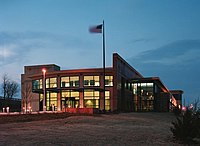Green buildings

When we talk about green buildings, we mean houses, offices, and schools that are built in a way that's good for nature. These buildings are designed to use less energy and water, reduce waste, and have a smaller impact on the environment. A green building has many things that are different from a normal building, and I'll explain some of these things below:
1. Efficient insulation: Green buildings have good insulation that helps to keep the temperature inside the building stable, no matter if it is cold or hot outside. This means we don't need to use as much energy to keep the building warm or cool.
2. Energy-efficient appliances and lighting: Green buildings have special light bulbs and appliances that use less energy. They are designed to use less power and reduce our carbon footprint.
3. Solar panels: Some green buildings have solar panels on the roof. These panels use sunlight to create energy that can be used in the building, and this energy can be used to power lights, computers, and other electrical things.
4. Rainwater harvesting: Green buildings have ways of collecting rainwater and using it for washing and flushing toilets. They have a system that takes rainwater from the roof, filters it, and stores it in a tank before it's used.
5. Low-flow systems: Green buildings use toilets and showerheads that use less water, and this helps to reduce the amount of water we use.
6. Renewable materials: Green buildings are built using materials that are better for the environment, instead of using materials that are harmful. For example, some green buildings use wood from trees that have been grown and harvested in a sustainable way.
In summary, green buildings are built with the aim of preserving the environment and consuming fewer natural resources. They are architecturally designed to be energy efficient, use renewable materials, and operate at a lower cost compared to conventional buildings.
1. Efficient insulation: Green buildings have good insulation that helps to keep the temperature inside the building stable, no matter if it is cold or hot outside. This means we don't need to use as much energy to keep the building warm or cool.
2. Energy-efficient appliances and lighting: Green buildings have special light bulbs and appliances that use less energy. They are designed to use less power and reduce our carbon footprint.
3. Solar panels: Some green buildings have solar panels on the roof. These panels use sunlight to create energy that can be used in the building, and this energy can be used to power lights, computers, and other electrical things.
4. Rainwater harvesting: Green buildings have ways of collecting rainwater and using it for washing and flushing toilets. They have a system that takes rainwater from the roof, filters it, and stores it in a tank before it's used.
5. Low-flow systems: Green buildings use toilets and showerheads that use less water, and this helps to reduce the amount of water we use.
6. Renewable materials: Green buildings are built using materials that are better for the environment, instead of using materials that are harmful. For example, some green buildings use wood from trees that have been grown and harvested in a sustainable way.
In summary, green buildings are built with the aim of preserving the environment and consuming fewer natural resources. They are architecturally designed to be energy efficient, use renewable materials, and operate at a lower cost compared to conventional buildings.
Related topics others have asked about:
